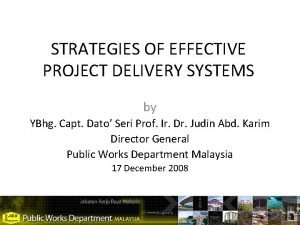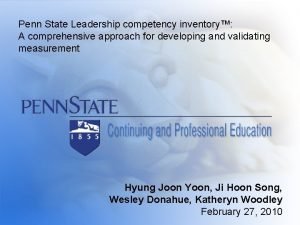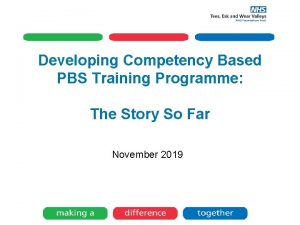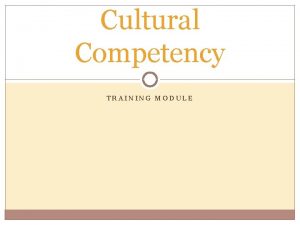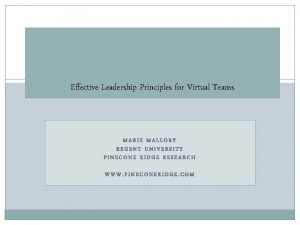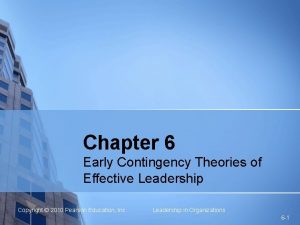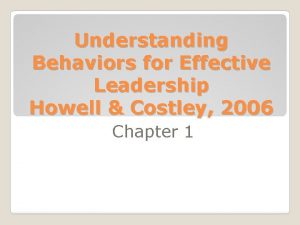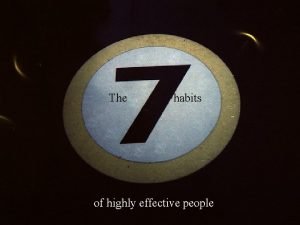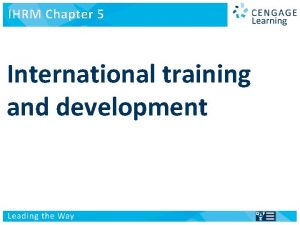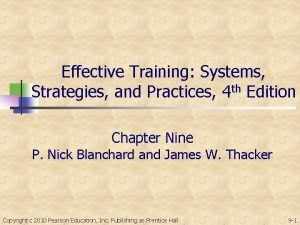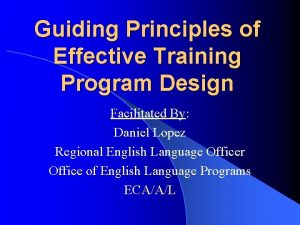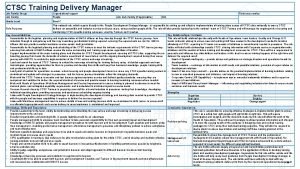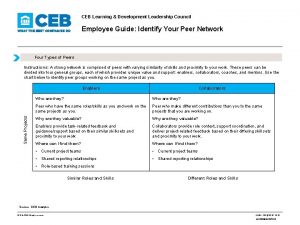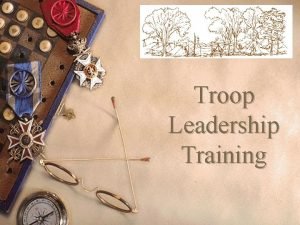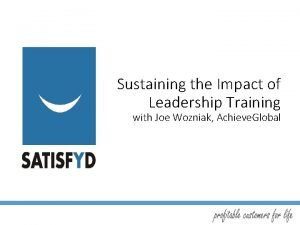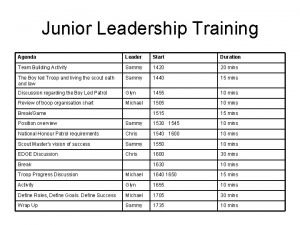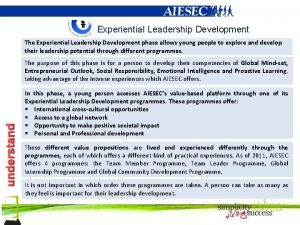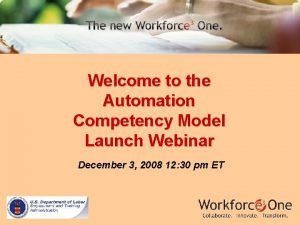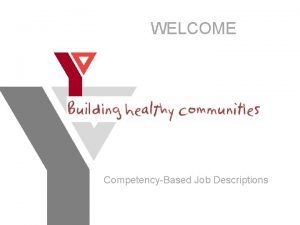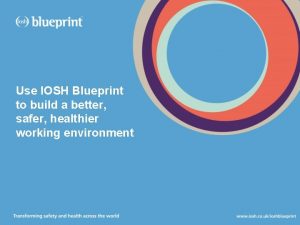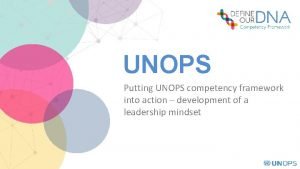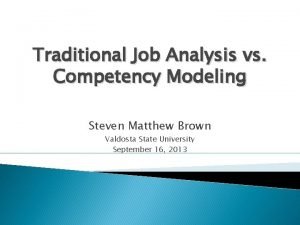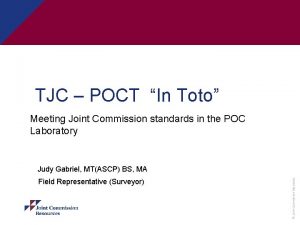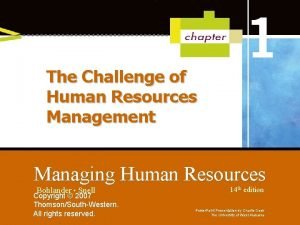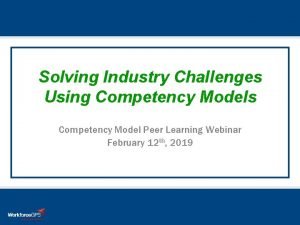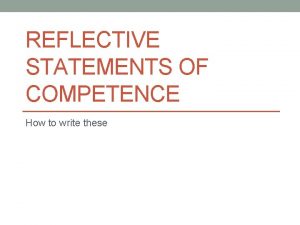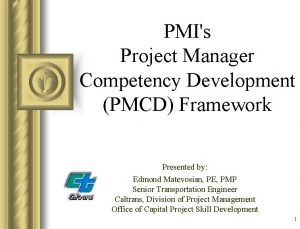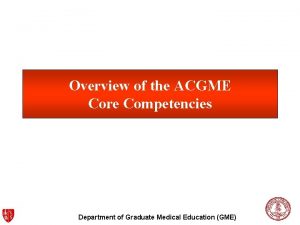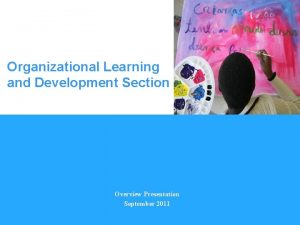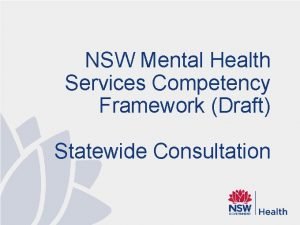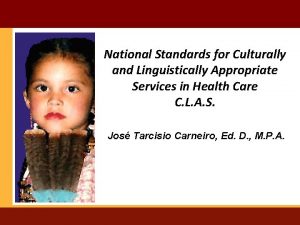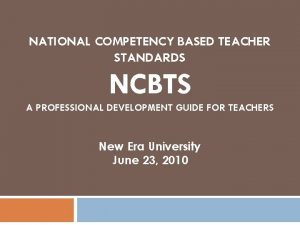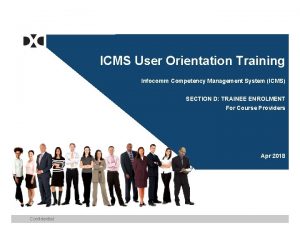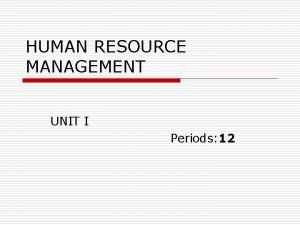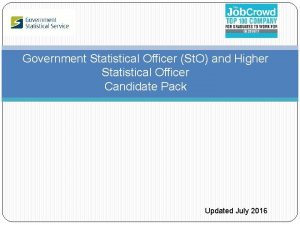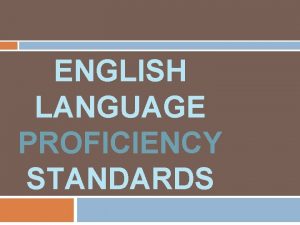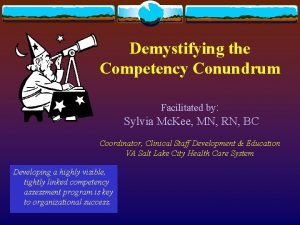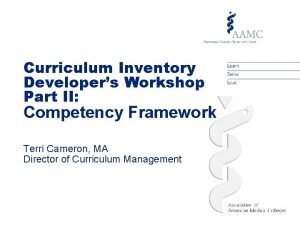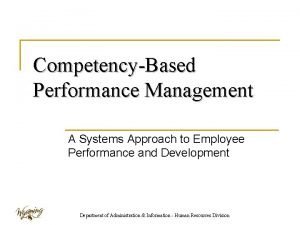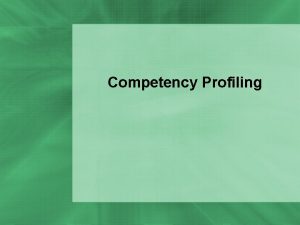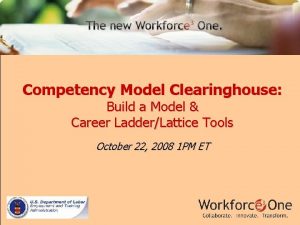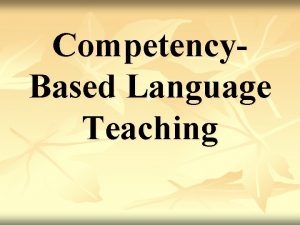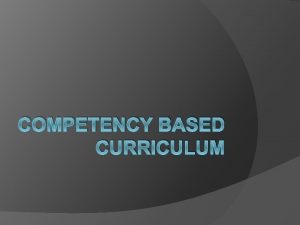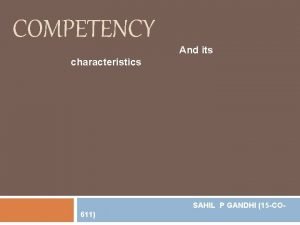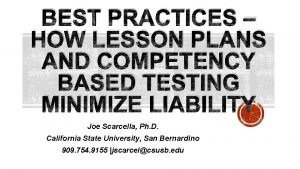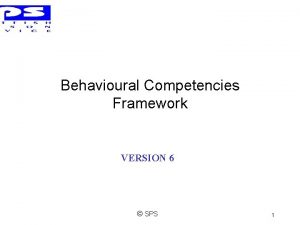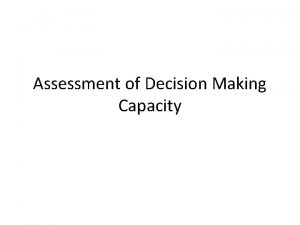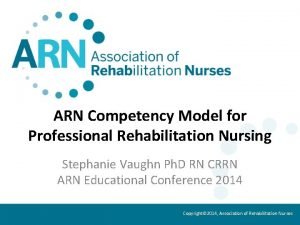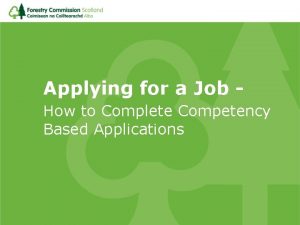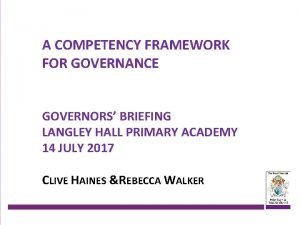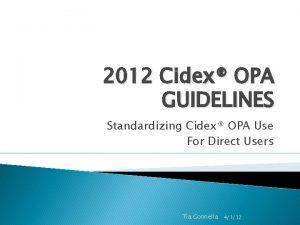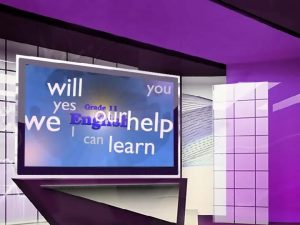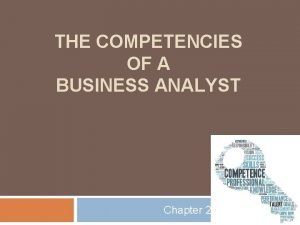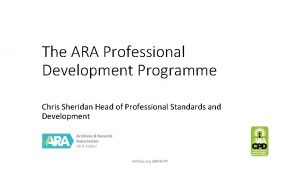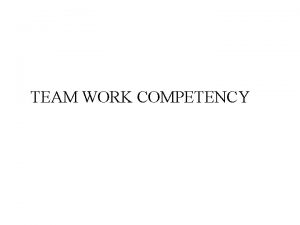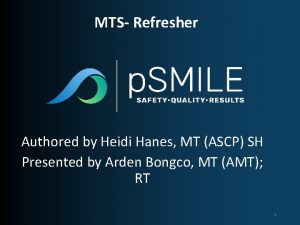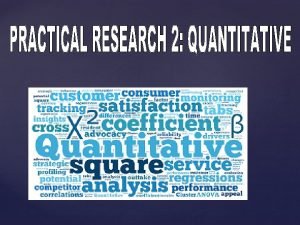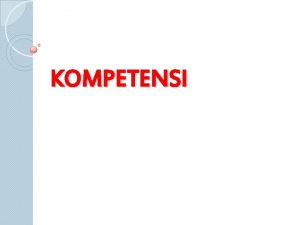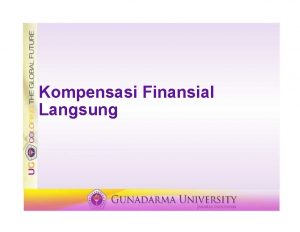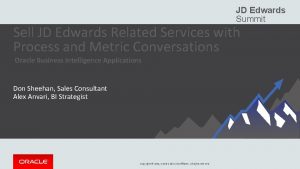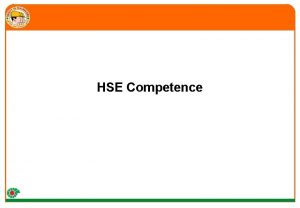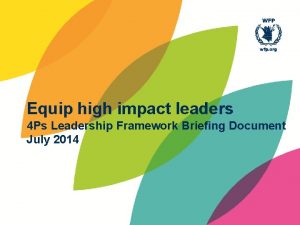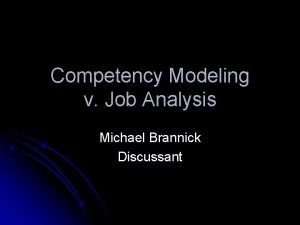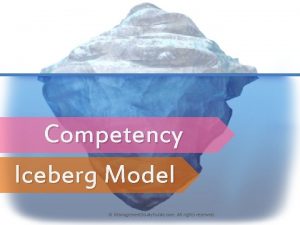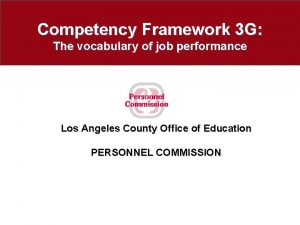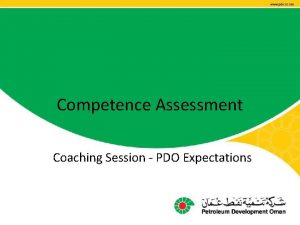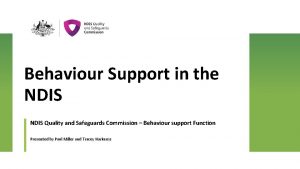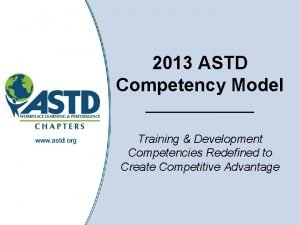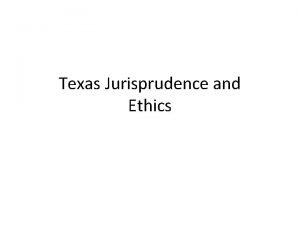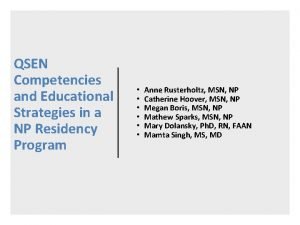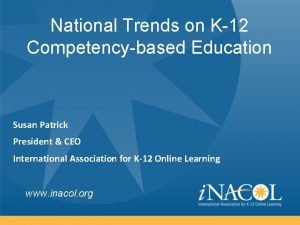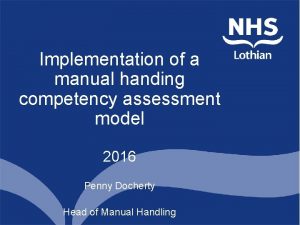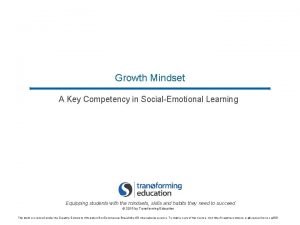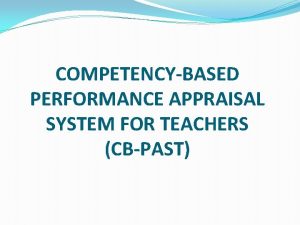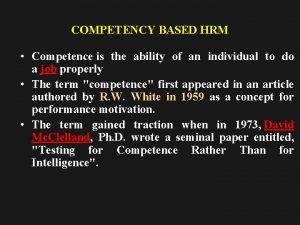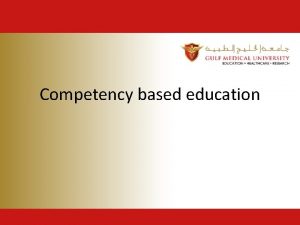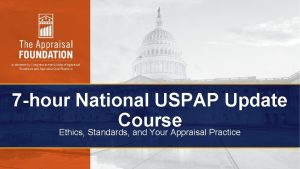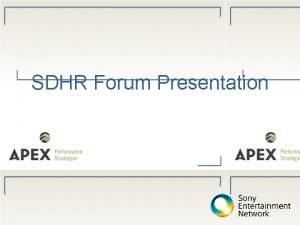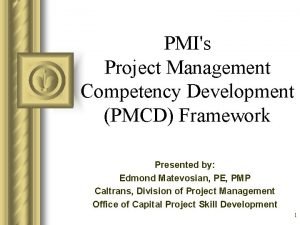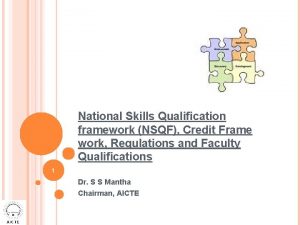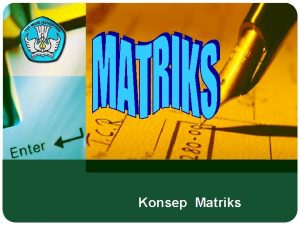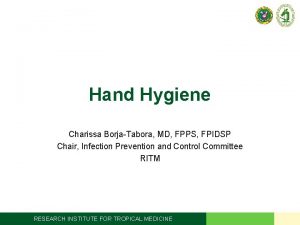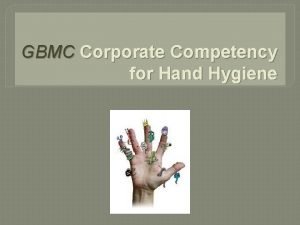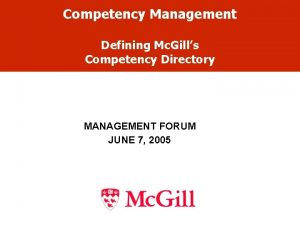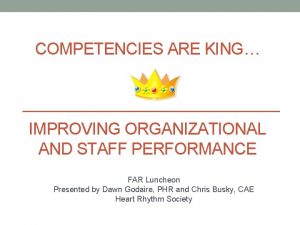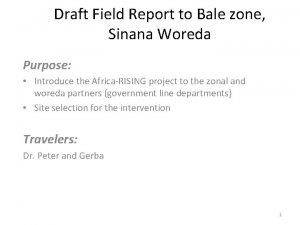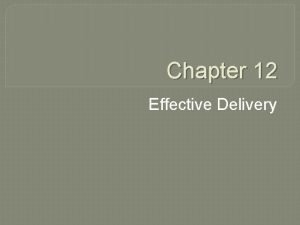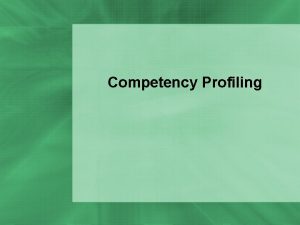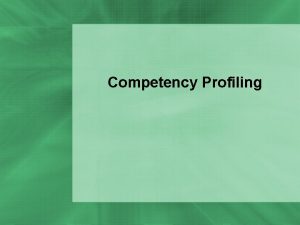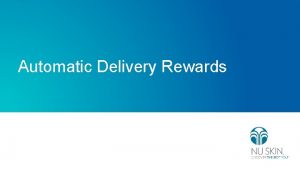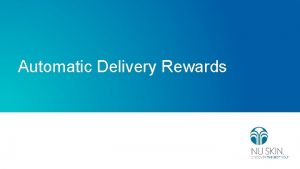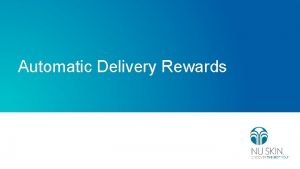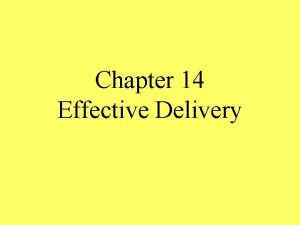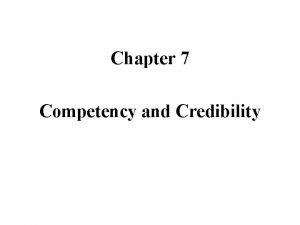WOREDA LEADERSHIP COMPETENCY TRAINING FOR EFFECTIVE DELIVERY OF

























































































































































































- Slides: 185

WOREDA LEADERSHIP COMPETENCY TRAINING FOR EFFECTIVE DELIVERY OF ‘PSNP’ Duration, Year, Venue

Introduction Official opening Know each other • Full name • Organization • Position title • Year of experience (and in PSNP) • Expectation from this training • One critical PSNP implementation challenge

Learning Objectives Overall objective: Improving the understanding and engagement of leaders and managers to wards effective delivery of PSNP Specific objectives: a. Improve their program knowledge of leaders and managers, b. Provide informed and consistent leadership for effective program implementation, and c. Increase their oversight and accountability for program compliances and delivery of the intended outcomes.

Module II: Enhancing leadership and management competencies for PSNP Module I: Bridging the program (PSNP) knowledge gap Module One Module Two Effective Program Delivery

Module I: Bridging the program (PSNP) knowledge gap UNITS/SESSIONS: PIM Guidance Notes & To. Rs 1. Program Mngt & coord 2. Annual planning 9. Safeguards and social accountability 3. Capacity Development 10. Procurement 4. Targeting 11. Financial management 5. Transfers 12. Monitoring and reporting 6. PW & links to social services 13. Job aid for frontline staff 7. Livelihoods 14. HRM 8. GSD-Nutrition 15. PRM To. Rs for PSNP Committees (PSC, FSTF, PW-TC, LH-TC, T& RM-TC

Module II: Enhancing leadership and management competencies for PSNP UNITS / SESSIONS 1. 2. 3. 4. 5. 6. Leading vs managing Stakeholder management Effective meeting matters! Human resource mngt Physical resources mngt Situational leadership 7. Leadership intelligence 8. Building and leading team 9. Trust building 10. Feedback 11. Time management 12. Delegation

Adult Learning Approach Adult Learning Setting Experience • Every one engages • everyone teaches • everyone learns Application ERGA Reflection Generalization 20% 10% Learning from Structured others learning 70% Learning by own • Manages diversities • Learns more by doing, from others (peers) • Hard on issues, soft on people 7

MODULE ONE BRIDGING THE PROGRAM KNOWLEDGE GAP

Module I: Objectives At the end of the training, participants will be able to: a. explain the key aspects of PSNP (objective, principles, operational processes), b. ensure compliances to the core elements of the program.

UNIT ONE PROGRAM OVERVIEW

Unit objective At the end of this Unit participants will be able to: • describe the program design elements, and • provide oversight for their compliances

If some one asks you, how can you briefly describe PSNP?

Phases of the PSNP 2005 -2006 Transition from relief 2010 -2014 Expansion phase 2007 -2009 Consolidation phase 2015 -2020 Transition from program to integrated Gov’t system

Key features of the PSNP is one of the flagship gov’t programs that: • Supports the poorest people • Covers broader geographic areas • Involves different stakeholder & partners • Operationalizes at multiple levels • Mobilizes significant financial resources • Builds strong institutional structure & system • Well staffed – quantity and quality • Integrates with overall dev’t plans

Some enhanced features of the PSNP 4 what each does mean? Some innovations Transition to a system Linkages & complementarities Integration of livelihoods to PSNP Systematic capacity dev’t Strengthened continuum of response

GTP PSNP 4: Alignment of PSNP with the higher level development objectives … shifting from program to system Goal #5. Reduce the number of chronically food insecure households PSNP • Social Protection • Disaster Risk Management • Climate Resilience & Green Economy • National nutrition

PSNP Result Chain Ouput_1: Prioritised instruments and tools in place to support an effective system for Social Protection and Disaster Risk Management Goal Resilience to shocks and livelihoods enhanced, and food security and nutrition improved for rural households vulnerable to food insecurity. Outcome “Enhanced participation in improved rural safety net, livelihoods and nutrition services by food insecure female/male headed households”. Ouput_2: Appropriate, timely and accessible transfers received by male and female clients Ouput_3: Sustainable community assets built up and access to social services enhanced Ouput_4: Client livelihoods opportunities facilitated through three pathways: crop and livestock, off-farm income generation, and employment Ouput_5: Effective management and operational processes in place to manage the programme

Core Principles of PSNP 1. 2. 3. 4. 5. 6. 7. 8. 9. Fair and transparent client selection Timely, predictable & appropriate transfers Primacy of transfers Productive safety net Tailored livelihood solutions Integrated into local systems Scalable safety net Cash first principle Gender equity

Participants’ reflection What did you learn and motivates most about PSNP? How will you then effectively support the program implementation?

• PSNP is an important flagship program covering wider geographic areas and significant number of the poorest in the rural areas • PSNP is strongly aligned with higher level government policy objectives, showing that it has been moving from standalone program to an integrated government system. • PSNP is therefore a priority for leaders and managers.

UNIT TWO PSNP IMPLEMENTATION AND COLLABORATION MECHANISMS

Unit objective At the end of this Unit participants will be able to: • explain the institutional arrangements of the program to effectively work for the program.

• Which are the key stakeholders for PSNP? • What motivates them to work with PSNP? • Are these stakeholders effectively coordinated?

Fig 2. PSNP Management, Coordination and Implementation Structures at region & woreda Cabinet FSSC Regional Chair: President or Delegate Woreda Chair: Chief Administrator FSTF Chair at regional and woreda level: Head Agriculture & Head FS Food Security Office both at regional and woreda levels LH-TC PW-TC T&RM-TC Chairs at regional and woreda levels: Head FS Office Chairs at regional and woreda levels: Head NRMD Chairs at regional and woreda levels: Head FS&EWR or Extension Desk

Woreda Level Roles & Responsibilities for PSNP • Determine needs, undertake planning and implement PSNP Woreda Administration • Oversee, manage and coordinate PSNP implementation • Manage transfers, procurements, financial and other program resources • Coordinate and integrate NGOs to support PSNP implementation

• Oversee overall PSNP implementation • Allocate PSNP budget and other resources Woreda Council • Guide & oversee PSNP integration into the woreda plan • Guide collaboration & linkages between PSNP & other sectors • Assist in addressing unresolved appeals by Kebele Council • Ensure posting in public locations of up-to-date listings of clients & appeal resolutions • Approve use of the woreda contingency budget • Approve action plans & review performance of PSNPIAs • Monitor implementation of commodity & financial audit findings

• Ensure accountability for PSNP performance Woreda Cabinet • Approve PSNP resources based on WFSTF recommendation • Guide & oversee integration of PSNP into the woreda plan • Approve action plans & review performances PSNP IAs

• Manages the Safety Net at woreda level. Woreda Agriculture Office (WAO) • Integrates the PSNP activities into the woreda rural development strategy • Oversees the implementation and management of the PSNP with support from Committee structures (FSSC, FSTF, TCs)

Woreda FS Desk/Process: • Coordinates PSNP activities and technically accountable to the Regional FS • Ensures that PSNP contingency plans are prepared and implemented correctly • Facilitate collaboration with other sectors • Holds quarterly technical review meetings with IAs • Submits progress reports to the WAO • Maintains and share accurate records of kebele Safety Net activities and list of clients • Manages client cards,

• Manages the delivery of food transfers in woredas, • Facilitates the continuum of response, • Ensures the timely delivery of food transfers in coordination with FS Desk/Process • Reports on food deliveries, stocks and payments to FS Roles and Desk/Process on a regular basis responsibilities • Provides accurate and timely early warning information EWR Desk/ Process • Prepares/amends woreda contingency plans to include (EWRD/P) the scaling up of the PSNP • Ensures adequate linkages between contingency budget resourced activities and other actions related to humanitarian response • Co-chairs the woreda TC on transfers with the Woreda FS Desk/Process

Natural Resource Management Desk/Process • Manages PSNP PWs, with support of FS Desk/Process. • Reviews PWs plans in coordination with other woreda offices • Consolidates kebele PWs plans and budgets • Ensures integration of community watershed and PW plans into woreda plan • Provides assistance to DAs and communities • Implements the ESMF for PWs and ensure compliance • Supervise and support PWs with FS Desk/Process, • Support the M&E system (PWs review) • Facilitate experience sharing among kebeles • Chairs the Woreda PW-TC and coordinates relevant line offices/desks and other PSNP actors in PW activities

• Consolidate kebele livelihoods plans and budgets • Ensure integration of livelihoods plans into woreda plan • Provide assistance to DAs and communities Extension Desk/Process • Implement the ESMF for livelihoods • Support the M&E system (for livelihoods review) • Facilitate experience sharing among kebeles • Analyze women and youth participation Through the TC: • Holds quarterly livelihoods progress review meetings • Coordinates relevant line offices/desks and other PSNP actors

Woreda Office of Labour and Social Affairs • Provides services to PDS clients and linkages to labour markets for the employment livelihoods pathway. • Supports the FS Desk in its activities related to the PDS clients • Reviews needs of PDS clients and refer them to any available services. • Manages program support to PDS clients and link them to complementary services according to their needs • Coordinates with the Extension Desk/Process and TVET to link PSNP clients to employment-related skills training and to employment opportunities

• Manages and implements activities in the off-farm livelihoods pathway of the PSNP Woreda MSE Dev’t Agency • Coordinates with the Extension Desk/Process and TVET to link PSNP clients to off-farm skills training and to employment opportunities • Provides entrepreneurship training, certify clients who have completed TVET trainings, and support the development of business plans for off-farm activities

• Provides technical training to clients in off-farm and employment related skills. Technical and Vocational Training (TVET) Institutes • Assesses local market for off-farm products and services as well as labour opportunities • Provides training to clients in off-farm skills and employment-related skill

• Co-chairs the Livelihoods Technical Committee Livestock Development Desk • Provides technical assistance for livestock-related livelihoods • Provides training to DAs and program clients in livestockrelated livelihoods • Reports livestock technical assistance to PSNP clients to the Woreda Extension Office

• Supports financial literacy training and savings promotion, Woreda Cooperative Promotion Office • Supports PSNP clients in obtaining access to markets and inputs, primarily in the crop and livestock livelihoods pathway. • Provides financial literacy training • Supports savings • Coordinates with the Extension Desk/Process to link PSNP clients to inputs and markets as needed

Woreda Health Office • Facilitates the provision of services to PSNP clients within the context of the soft-conditionality • Ensures Community Nutrition conversations prior to the PSNP planning process • Provides nutrition BCC at PWs sites and other locations • Supports and oversees HEW and health development army provision of C-BCC for PWs clients • Ensures quality implementation of nutrition sensitive PWs • Reviews adherence to the soft conditionality of PSNP clients • Tracks participation of PSNP clients in nutrition BCC and antenatal care • Review monthly progress reports on PSNP activities and ensure that HEWs report regularly on their involvement in PSNP

Other Woreda Sector Offices (Education; Water; Road, and Women, Children and Youth Affairs) • Participates in PSNP planning, implementation, monitoring and reporting • Consolidates and incorporates proposals of the Kebele FSTF into the woreda PSNP and sectoral plans • Prepares activity plans and request budget for implementation • Implements PSNP activities at kebele and community levels • Provides technical assistance and training to technical personnel and kebele staff • Undertakes project screening in accordance with the ESMF • Conducts M&E activities in collaboration with others woreda stakeholders • Prepares quarterly progress and financial report

Woreda Office of Finance • Oversees the financial management of the PSNP • Ensures that the budget for the PSNP is received in a timely manner at the woreda level • Undertakes timely PSNP payments for client households, • Supervises personnel, and the purchase of relevant equipment and materials • Exercises necessary fiduciary controls and report on fund utilization to regional bureau of finance.

NGOs • Provide transfers and oversee PWs in some woredas, and implements or supports livelihoods activities in others • Participates as members of the Woreda FSTF • Participates in the Livelihoods TC • With additional financing, contribute their capacity and expertise to the program • Work with government structures and abide by the PIM

Brainstorming Are these PSNP Committees in place and active? If not why?

PSNP Collaboration in Practice: TC/TF Functionality (TASC Report, 2010 EFY) % TC meeting conducted # times as required by the PIM ) 35% 30% 25% 20% 15% 10% 5% 0% 31% 15% Region Woreda Operationalization of the PSNP coordination mechanisms are generally less effective. Why?

Exercise #1: TC/TF Functionality (15 Min) Action plan to increase effectiveness of TC/TF Activity Resp. body Time

TC/TF Performance Indicators … 1. Committee Effectiveness (TC/TF) • Each committee holds regular meetings • Ensure attendance is over 75% • Maintain meeting records (e. g. agendas and minutes) • TC & TF communicate regularly (shared minutes) • TF provides feedback to be implemented by TC

TC/TF Performance Indicators … 2. Planning, Monitoring & Reporting • Ensure IAs deliver their roles and responsibilities for PSNP on time • Joint preparation and timely submission of the annual PSNP plan in accordance with the PSNP’s Planning Guideline • Joint monitoring and implementation support provided • Timely submission of the quarterly PSNP progress report • Timely submission of the quarterly financial report

3. Core PSNP performance TC/TF Performance Annual re-targeting is conducted fairly and in a timely Indicators … manner (before June 30 th ) Achieve timely transfer payments to clients (20 day for cash, 30 days for food) Implement a harmonized PSNP and HFA system (one targeting and one appeal committee at kebele levels) ESMF screening and implement mitigation measures for PW sub-projects Map mature PW subprojects and ensure a PW-Livelihoods linkage which benefits clients Regions allocate adequate loan funds for clients /IGAs Regions collect and revolve loan funds for livelihoods clients / IGAs Undertake evidence-based graduation of PSNP HH

UNIT THREE ANNUAL ‘PLANNING for PSNP’ A good plan is half-way to successful implementation. Quality and timely annual plan thus matters.

Unit objective At the end of this Unit participants will be able to: effectively apply and comply with the PSNP annual planning process, standards and templates (quality) and timeliness.

How Good are the PSNP Planning and Reporting practices and products: • • Compliance to participatory process Compliance to deadlines Alignment with results Meeting accountability

PSNP planning … • A two way process • A top down – planning information & priorities • A bottom up – community and sector PSNP plans • Applies standard planning and budgeting templates • Annual plans integrated and consolidated at different levels • Integrated with overall development plan at each level • Integrated cross cutting issues: capacity development, GSD and Nutrition, and environment

Annual planning process and timeline However, preparing a good plan remains an issue.

Budgeting for PSNP Budgeting Challenges Prioritization Fair allocation of woreda administrative remains an issue.

UNIT FOUR PSNP MONITORING AND REPORTING Increased expectation for greater efficiency, effectiveness & accountability.

Unit objective At the end of this Unit participants will be able to: effectively apply and comply with the PSNP monitoring and reporting process, standards and templates (quality) and timeliness.

System for PSNP • Monitoring/progress reports: • Monthly from woreda to region, and • Quarterly from region to federal to DPs • IFR - quarterly and annual financial reports • Information Centre Report – Timeliness of transfer & price (every two weeks) • RRM Reports (every two months) • Process Review (every six month in highland, every quarter in low land regions) • Annual Livelihoods and PW planning review • Annual PW & Livelihoods Implementation review • PW implementation and impact assessment (every two years) • GRM Review • Independent annual procurement assessment • Financial Audit (six-monthly interim audit, rolling, and annual) • Annual commodity audit • Impact evaluation – every two years Why PSNP requires all these control mechanisms?

Responsibility and Timeline for PSNP Reporting

Basic Requirements and Practices of the PSNP Annual Planning 1. Quality • Need based - informed by critical • • review and needs assessment Compliance to templates Compliance to process – stakeholders engagement Alignment and synergy within/with Justification for the proposed actions / approach Completeness and accuracy Consistency of presentation English 2. Timeliness • Annual plan submission delayed by several months. Quality and timeliness of annual plan and report remain a concern though improvements. Poor quality Plan and Report incur rework & reputation costs

Exercise #2. 1: Reflect on your PSNP Annual Planning Experience Reality Check for Meeting the Quality & Timeliness of PSNP Annual Plan Action plan to improve PSNP annual planning (2012 EFY) Activity Strength 1. 2. 3. PLAN/ REPORT 1. 2. 3. Weakness Resp. body Time

UNIT FIVE CAPACITY DEVELOMENT APPROACH TO ‘PSNP’ Capacity development is an important means to a change process, yet the most conventionally handled.

Unit objective At the end of this Unit participants will be able to oversee the application of the PSNP CD systems

How effectively work the Capacity Development intervention for the PSNP? • Moving to systematic approach? • Impacting performance improvement?

Capacity is an ABILITY of an individual, team, or organization to achieve its vision and goal. Capacity for performance improvement and change. K S E 2 Performance Ca pa cit y. D Management ce an PSNP rm K = Knowledge, S = Skill, E = Enabling environment rfo Pe ev ’t Competencies

PSNP 4 CD STRATEGY (2016) STRATEGIC OBJECTIVES STRATEGIC GOALS Human and Physical Capacity Systematic CD Approach Effective program delivery Need Based CD Institutionalizing CD Program Coordination & management Institutionalizing CD

Systematic Approach to PSNP CD

Integrating CD with Gov’t Institutions Institutional elements of PSNP CD • CD home • CD strategy • CD plan • CD budget • CD governance (regional CDTAC, WFSTF) • CD coordinators (Regional and woreda focal) • Champion facilitators (regional level, and to rollout to woreda) 4 Institutionalization 1 Consensus Building 2 3 Capacity Application Capacity Strengtheni ng

Approved Maximum CD event participant class size Training of Trainers (35 people) Rolling training (45 people) Workshop (35 people) Maximum CD participants under PSNP Awareness raising (100 people) Are CD activities complied to these standards? Who specifically oversee their enforcement?

Exercise #4: Reflect on your PSNP CD experience Reality Check for effectively enforcing the CD strategy, and complying with the CD Planning and Reporting Action plan to improve PSNP CD strategy implementation Activity CD Strength 1. 2. 3. Weakness Resp. body Time

Summary • CD is not a one-off activity; it is a continuous process. • CD efforts must be aligned with performance improvement. • CD must be systematic. The conventional approach couldn’t help addressing the performance issue. • Training along is not enough. The learning must be applied to meet the training purpose. • CD is one of the management functions, thus the responsibility of leaders and managers.

1 2 3 4 5 6 CD Monitoring Indicator % of Woredas meeting the minimum safety net staffing standard % of Woredas maintaining an updated record of PSNP physical resources % of CD training programme materials for govt staff aligned with CD approach guideline # of regional CD plans incorporating CD activities from all PSNP govt and partners IAs % of approved woreda regional CD training plans completed and implemented. # of regional CDTAC meetings held and minutes recorded per year (proxy for coordinating CD max 24)

7 % of PSNP Joint Action Plans developed through ESAP that are implemented 8 # of PSNP woredas fully implementing at least 30% women participation in KAC 9 % of sampled rural safety net kebeles with a functional KAC operating for both PSNP and HFA 10 % of sampled kebeles where targeting of PSNP core caseload and transitory transfers are targeted using one committee structure 11 % of sampled kebeles where KFSTF have 2 or more female members 12 % of FSTF meeting held

UNIT SIX TARGETING AND GRIEVANCE REDRESS MECHANISM Evidence based clients’ targeting critically determines the success of the program.

Unit objective At the end of this Unit participants will be able to: • oversee compliance with the quality and timeliness of the annual clients’ verification processes.

• How transparently and effectively the targeting of HHs for PSNP has been taking place? • What are the most outstanding concerns and challenges in targeting and their implications?

Five ways of targeting HHs for PSNP support Public Work (PW) Temporary Direct Support (TDS) Permanent Direct Support (PDS) Livelihoods Technical support Livelihoods Transfer

Targeting Criteria Component HH Eligibility Criteria 1. 1 PW Community member Chronically food insecure - faced continuous food shortages (3 months of food gaps or more per year) in the last 3 years Has become suddenly food insecure as a result of a severe loss of assets, especially if linked to the onset of a severe chronic illness, such as AIDS No adequate family support or other means of social protection and support Has at least one adult-member able to participate in public works Additional criteria 1. 2. TDS • Pregnant (as of the 1 st or 4 th months of pregnancy) and • lactating women (up to one year after birth), • people with temporary illnesses, and • primary care-givers of malnourished children will transition to TDS

Component HH Eligibility Criteria 2. PDS The above criteria plus No adult able-bodied labor Female-headed households (FHH) with high dependency ratio (four or more dependents) 3. Livelihoods 3. 1 Livelihoods A member of the household is benefiting from either Permanent Technical Direct Support or Public Works and Temporary Direct Support Self-selects to participate in the livelihoods component

3. 2 Livelihoods A member of a HH benefiting from either PW &TDS, PDS Transfers Selected through a community process as needing additional support before embarking on livelihoods investments. Prioritizes female HH heads, landless youths, members of the poorest HHs, members of other HHs for whom credit is not an option. A HH may only be targeted for one livelihoods transfer The total number of HHs targeted for the livelihood transfer is upto 10% of kebele and woreda PSNP caseload

4. Risk Management HHs having successfully appealed wrongful exclusion from (contingency budget) PSNP transfers HHs having at least one malnourished child under the age of five who receive Targeted Supplementary Food or benefits from Community Management of Acute Malnutrition HH have been affected by a shock.

Targeting instruments: • Community targeting, • Wealth ranking to identify ultra-poor clients for Livelihoods transfer.

Targeting …. Allowable family size for safety net support: • The five-member household cap is eliminated in the ERPSNP. • Regions will decide how to best support PSNP HHs within the overall caseload and budget. • All eligible HH members will be listed as clients of the program. • If community targeting of livelihoods transfers done at the same time, the CFSTF will at this point apply Wealth the Ranking.

Annual Process: The annual program entry and exit process involves: a. Identification of potential program graduates b. Re-certification of program clients of the PDS and PW components c. Targeting of the livelihoods component

PSNP Appeal Mechanism Kebele Appeal Process: The appeal process involves carrying out the following activities: • Establish a unified appeal process for all aspects of PSNP and HFA implementation as part of Social Accountability and GRM • Create access to existing Kebele Appeals Committees (KAC) and to the Woreda Cabinet for unresolved complaints. • KAC to schedule quarterly meetings. • KAC to review the evidence and make recommendations on unresolved cases. • KAC to provide a listing of the appeals and the associated resolutions to the Kebele Council, Woreda Council and Wo. A % of complaints addressed within one month of initial complaint being recorded.

Monitoring indicators for Targeting • Ensure transparency through strengthening community involvement • Undertake and apply the annual wealth assessment to complement community verification • Strengthen KAC (independence and documentation) to address grievances • Ensure HHs with accepted appeals are differed for contingency budget support

Summary • Targeting is the first critical success factor for the program. • Compliance for quality targeting in terms of transparency and objectivity is an outstanding concern. • Delay in targeting is also another concern to work on. It contributed to delay in timeliness of transfer. • A high level decision to under take the annual verification process early and to complete and report before mid June every year. • The annual caseload will then be integrate with the annual plan. • All these consideration calls for a strong and consistent oversight and assurance of leaders/managers

UNIT SEVEN TRANSFERS TO CLIENTS Timeliness of transfers is key to smoothen consumption and prevent assets depletion of food insecure HHs.

Unit objective At the end of this Unit participants will be able to: • Explain the importance of timeliness of transfer: smoothen consumption and prevent asset depletion by clients.

What is the average transfer rates to clients by region or woreda • Achievement rate that meet the target? • Major challenges and lesson learned • Opportunities for improvement • Roles of leaders and managers in the past and in the future

Types of Transfers to clients Core transfer: PSNP provides predictable safety net support (cash or food transfers) to 8 million chronically food insecure people in chronically food insecure rural areas: • in exchange for participation in public works or • as direct support. Transitory transfer: HFA provides food and cash transfers to households that are food-insecure because of a shock, most often drought, in rural areas.

Core principles of transfers Approrpriate Predictable Individual client to receive 15 kg/ month of the core transfer Knowing the type, amount and time to receive transfer by clients (confidence) Accessibility Payment to clients be effected within 2 km Timely Clients to receive core transfer in 20 days for cash & 30 days for food Transitory clients to receive within 60 days Primacy Clients right to receive timely transfers regardless other factors

Payment Procedures a. Annual transfer schedule b. Transfer Modality: • A timely and predictable payments to clients • Clients’ right to know in advance how much is coming and when. • Cash as the primary form of transfer whenever possible. • Food transfers when food is not available or market prices are too high c. Duration of transfer to clients: • 6 months for PW clients • 6 months for TDS) clients • 12 months for PDS clients d. Use of PASS

Process flow chart for payment to PW clients

Mode of Transfers to Clients Food Voucher Traditional Cash Payment Mode of Transfers Food Transfer Electronic Cash Payment

Transfer performance status and challenges (Nov. 2018 JRIS Aide memoir) • Timeliness and predictability of transfers still does not meet program standards. • Only 43% of cash transfers and 23% of food transfers were delivered as per program standards during the first six months of EFY 2011. • What are the challenges for transfer? • In what ways can improve performance in transfer then?

Factors that contributed to the delay of transfers (Nov’ 18 JRIS) a. delay in re-targeting; b. delay in attendance sheet and payroll preparation due to delay in submission of attendance sheets on time • lack of commitment, coordination, and accountability at woreda c. d. e. f. delay in food dispatch (weakness in food management system); limitations on e-payment implementation; staff reshuffle and turnover mostly at woreda level; limited branches and cash holding capacity of the bank (in the case of Somali region); and g. lack of transparency and clarity on the methodology of cash wage rate adjustment.

Agreed action points by the Nov’ 18 JRIS a. b. c. d. e. Finalized retargeting before mid-June with the regional annual plan Set a fixed payment process schedule by each regions Strengthen CMU on food management system Strengthen accountability at all levels (apply individual performance rating Resolve E-payment problems i. e. woreda FSD provides consistent payrolls to MFIs and notify in advance if there are changes. f. Proactively provide orientation and training for the new officials and staff of PSNP g. Follow up the implementation of Mo. F’s request to CBE to open up additional bank branches (in Somali and Afar) and increase cash holding limits and h. Mo. F to communicate the methodology and other details of the cash wage rate adjustment assessment to be conducted and completed by April 2019 to be applied in EFY 2012.

Agreed Action Plan to Timeliness of Transfer Action No. of Day of the Days Month Print attendance sheet format with list of PW participants 5 25 th before using PASS (woreda to Kebele) end of month Reporting on the attendance (list of present/Absent of PW 2 27 th before participants) in two days (by foremen) to the DA end of month Submitting completed attendance sheet from kebele to 4 4 th after end woredas in four days after receiving the list of present / of month Absent PW participants (DAs) Preparing attendance sheet / uploading to PASS in three 3 7 th “ “ days after receiving attendance sheet from DAs (by WFS) Preparing payroll in three days after receiving the 3 10 th “ “ attendance sheet Cashiers make payments to clients in ten days (the above 10 20 th “ “ actions add up to total of 20 days for cash payments)

1 2 3 4 5 Transfer Monitoring Indicators % of resources received by clients within the agreed timeframe (20 days for cash and 30 days for food from the end of the previous month. % of core safety net transfers paid on time (payments to households from PASS reports) % of transitory clients receiving humanitarian food assistance (HFA) resources within 60 days % of PSNP core clients reporting that they receive cash or food transfers at a place less than 3 -hour walking from their home. % of transfers received that have a value of at least 15 kg of wheat person per month

6 Number of clients covered by the programme (chronic caseload) in millions 7 % of HHs reporting that use of transfers is decided jointly by HH head and spouse 8 % of PSNP woreda providing detailed information on the utilization of 5% contingency budget. 9 # of cash receiving PSNP woredas (and number of clients) using E-Payment system 10 # of woredas with upgraded version of PASS (from output-1)

Delay in transfer payment to clients means: • forcing clients’ to distress sale of their meager resources • Creating distrust of implementing government agencies The solution is simple. • Preparing and enforcing with accountability a monthly transfer plan. • Successful region and woredas have managed to make transfers to clients between 5 and 10 days

UNIT EIGHT PUBLIC WORKS AND LINKS TO SOCIAL SERVICES

Unit objective At the end of this Unit participants will be able to: • Prioritize PW subprojects that significantly and sustainably address food insecurity and poverty • Ensure timely preparation and submission of attendance sheet

How well PW sub-projects are planned and implemented? • Community participation in PW planning • ESMF compliance • Integration of GSD PIM provisions • PW-Livelihood linkage • Sustainability of PW subprojects • Integration of PW with overall plan • Roles of leaders / managers in PW • Challenges and lessons learned

PWs and links to social services component Focus and approaches of PW under PSNP: • addresses the underlying causes of chronic food insecurity. • follows the integrated community-based watershed in high land the rangeland mng’t approach in pastoral areas • involves community-based, labor-intensive sub projects • ensures that sub projects are gender and nutrition responsive • provides employment for able-bodied food insecure people • contributes to improving livelihoods, reducing risks and improving resilience

Key features of PW under PSNP 4 • Preparing a single PW plan for both core and transitory PSNP beneficiaries. • Expanded use of PW capital budget for: ₋ water harvesting and small-scale irrigation (livelihoods linkage) ₋ temporary child care center establishment • Increased contribution to livelihoods and higher dev’t objectives • Participation in Behavioral Change Communication (BCC) • Nutrition sensitive PW projects • Transition pregnant women from PW to TDS • Transition to direct support of primary care givers

PWs Planning: Some Considerations • Woredas define the major watersheds and the critical watershed units. • CBWS provides the basis for the planning watershed subprojects. • Community identifies needs for PSNP support (inclusive) • PW plans aligned with complementary interventions: livelihoods, nutrition, climate resilience and disaster risk management. • ESMF compliance - Identify potential risks and mitigating actions during planning • Give priority to activities that reduce women’s regular work burden and increase access to productive assets. • PD calculation should consider: 3% TDS, 50% workload reduction for women & 2% BCC. • DA in consultation with KFSTF review the community PW plan and compile it into the kebele PW plan

Main Roles of PWs Technical Committee A. Woreda level • Review prioritized kebele PW activities. • Review the available capital budget and matches with the labor input. • Develop in detail plan for utilization of the available capital budget. • Ensure PW subprojects are integrated into the overall watershed plan. • Review the contribution of PW plan to the 4 GO policy objectives. • Ensure the ESMF Screening Forms for the PW sub-projects completed • Check that the sectoral component of the PW plan are addressed

GSD PIM provisions • Sub-projects and activities should reduce women’s regular work burden • Encourage women’s engagement in the community and kebele watershed committees • Only able-bodied adult HH members are eligible to work at PW sites. • No able-bodied adult HH member is expected to work more than 15 days • PW site should not be far from their localities (within 2 kms of their village). • General health and safety orientation should be given before the start of PW.

Gender PIM provision … Promoting nutrition sensitive sub projects including: • latrines, • health post or living quarters for HEW, • child care centers, • crop and livestock-oriented PW projects, • homestead/kitchen gardens on the land of FHH with severe labor shortages, • social infrastructure rehabilitation, and caring of children in the temporary child care centers during implementation of PW.

Gender PIM provision … Nutrition, health & sanitation and BCC • Clients are expected to participate in at least 6 community BCC sessions. • Participation in 3 BCC sessions is equivalent to 1 PW day. • BCC sessions will be planned and organized by HEWs in coordination with DA and SW • BCC sites should be selected based on proximity to homes or PW sites. • Addressing nutrition challenges is the responsibility of the whole family and the wider community

Links to Social Services for PDS and TDS clients: PSNP clients are expected to take up health services as co-responsibilities including: • antenatal consultations, • post-natal consultation, • nutrition counseling, • growth monitoring & promotion, • vaccination & regular health checkups TDS transition • 1 year for lactating • 4 months after pregnant • Primary child care giver during treatment

PWs and Transfer Schedule Considerations for the timing and scheduling of PW • Expected to be timed to coincide with the slack labor period. • Transfers are expected during or prior to the period of greatest need. • Payments should take place immediately the completion of the work • The schedule for PSNP PW and mass mobilization should be set in a harmonized way.

Key PWs actors and responsibilities 1 2 3 Actors Clients • • CFSTFs • • • DAs • • • Key responsibilities Determine PW priorities with the whole community Execute PW Participate in monthly BCC session Participate in the relevant services - the co-responsibilities Mobilize community for PW planning Submit community PW plan to KFST Monitor implementation of PW Design PW with support from Woreda NRM Complete the subproject ESMF Screening procedure Co-facilitate BCC sessions Oversee implementation of PW Monitor implementation of ESMF mitigating measures Report on implementation progress of PW plan

Key PWs actors and responsibilities … 4 Key actors Woreda NRM desk/ process Key responsibilities • • • Chair woreda PWTC Review PW plan in coordination with sector offices Consolidate woreda PW plan Provide technical assistance to DA and communities on the planning process Ensure ESMF compliance procedure is followed Supervise PW and provide technical backstopping Support the M&E system, especially in PW reviews Facilitate CD trainings and experience sharing among kebeles Coordinate the involvement of relevant PSNP players

Selected Output Indicators PW monitoring indicators % of PW sub-projects constructed according to technical standards info-techs % of PW projects screened in accordance with ESMF Total area closure enhanced with biophysical SWC measure % of PW projects for which planned mitigating measures implemented Total area of land developed under SSI % of PW sub- projects for which operation and maintenance mechanisms established Percentage of pregnant women transitioning to temporary direct support before 4 months

UNIT NINE LIVELIHOODS The combination of livelihoods and other complementary interventions stimulate and actualize graduation.

Unit objective At the end of this Unit participants will be able to: • Clearly discuss on and support operationalization of the three pathways. • Strongly links graduation of clients with the successful implementation of the livelihoods component.

How well the Livelihood component of the PSNP are planned and implemented? • Assessment of livelihood opportunities • Selection of viable and sustainable IGAs • Quality of business plans • ESMF compliance • Saving mobilization • Credit financing • Training and technical support to clients • Roles of leaders / managers • Challenges and lessons learned

Livelihood component: Focus areas 1. Technical support to build household asset (three pathways) 2. Livelihoods transfers for ultra-poor households 3. Public works (PW) and livelihoods linkage

Overarching Principles of Livelihoods • Tailored technical assistance with appropriate institutional ownership • Tailored support to HHs and individuals according to their capacity. • Market-oriented and demand-driven livelihoods support. • Coordination and synergy with PWs and other complementary initiatives. • Simplicity of business plans • Careful sequencing and tracking of livelihoods interventions. • Harmonization of livelihoods interventions with other actors • Strong focus on learning and knowledge management • Compliance of client business plans with ESMF

Implementation modality 1. Direct training and technical assistance to clients by appropriate institutions. • Agriculture (crop and livestock) offices • Technical Education and Vocational Training (TVET) • Input and output marketing agencies 2. Conditional capacity building support for grassroots institutions that provide services to PSNP livelihoods clients, such as: • Farming/Pastoral Training Centers (FTC/PTC) • Rural Saving and Credit Cooperatives (RUSACCO) • Other Cooperatives and Micro Finance Institutions (MFI)

Livelihoods Identification Sequence and timing of LH intervention Market/Value chain and technical analysis Shortlist of IGA/Livelihoods investment Client Identification Community livelihoods consultation Targeting of households for livelihoods transfers Self-selection of clients for participation in livelihoods Initial list of livelihoods activities complemente d by PW Community prioritization for free livelihoods transfers and ready for livelihoods Preparation of annual plan in line with available resources

1. Livelihood identification process a. Community consultation and frontline training b. Shortlisting LH opportunities and IGA in each woreda based on market and value chains, and technical and labor market analyses. c. Verification of the shortlisted LHs opportunities by clients during the community consultation at the PWs d. Distinguish the clients into two livelihoods client groups; • Livelihoods technical support clients and • Livelihoods transfer clients. e. Woreda livelihoods offices support DA and (KFSTF) support the client identification process

Livelihood Implementation flow chart Crop and Livestock Pathway Crop & Livestock, Off-Farm and Employment Pathways Training Business plan preparation & Financial Approval & Referral Follow-Up Support Off-Farm Pathway Common to all Pathways Group Formation Initiation of Financial Literacy Client consulta tion Training Business Plan Preparation & Financial Approval & Referral Employment Pathway Training if Needed Employment Linkage Follow Up Support

Establishing LH support group prior to BP Operational standards: • 1: 50 DA to client ratio for crop and LS • 20 -30 members per group • 2 clients per HHs could participate • 4 -6 LH groups supported per year in each KA Purposes of forming LH groups are for: • provision of training, • mentoring and • coaching.

Possible livelihood options Clients choose their preferred options by considering: • their capacity • technical feasibility • market opportunity.

Financial training and saving mobilization • Initial financial literacy training & savings for livelihood groups • financial literacy for 2 hrs/day over 15 days or 2 hrs/week over 15 weeks • 5 days financial literacy equivalent to 2 days of PWs if provided during PWs • Provide group-based technical training after selecting the pathways technical support for LHs transfer clients by DAs • bi-weekly and for at least for two years. • Saving a precondition for client’s participation in LH • Clients may choose to save in one or more institutions: VSLA, RUSACCO or MFI.

Development of livelihood checklist DA to assist each selected livelihoods/IGA client in preparing a livelihoods checklist. Elements of livelihood checklist • Financial literacy training • Participation in savings • Technical training tailored to a livelihoods pathway • Business skills/marketing training tailored to a livelihoods pathway • Business plan development • Referrals for financing


Follow up support for livelihood interventions Key players and their role in LH implementation 1 Key actors Roles and responsibilities 2 Extensions Coordinates overall livelihoods activities Serves as chairperson or co-chair on the LHTC. Oversees the implementation of the crop and livestock pathway Provides technical assistance for the crop and livestock pathway 3 DA Supports business plan development and finance referrals Advises clients on the requirements of different types of livelihoods 4 Woreda SMS Provides technical training in the crop and livestock pathway Supports the preparation/review of business plans for feasibility and credit-worthiness 5 MSE/ rural Oversees the implementation of off-farm livelihoods pathway job Certifies training completion creation Supports the development of business plans and finance referrals

Key players and their role … Bo. LSA 6 TVET • Oversees the implementation of the employment pathway Provides technical training to clients in off-farm and employment pathways Provides entrepreneurship training to clients in the offfarm pathway Provides training on FL, marketing, entrepreneurship, risk mitigation and follow-up support 7 Cooperative Promotion 8 Wo. FEC • Disburses livelihoods transfers 9 Woreda youth Ensures prioritization of women and youth in livelihoods activities children and women Ensures that location and timing enable women to attend Implements activities to strengthen women’s confidence levels & negotiation skills

Key players and their role … 10 11 Key actors Roles and responsibilities Woreda Youth and Monitors and ensures participation of rural youth in livelihoods pathways (off-farm, sport employment linkage) Suggests areas of interest that benefit youth livelihood NGOs working in Fills gaps and harmonize their plans with the woreda’s overall plan the woreda Apply PIM in the implementation of PSNP related activities

GSD consideration in LH implementation • LH transfers targets the poorest PSNP HHs, FHH, & HHs with landless youth. • Participation in LHs is voluntary and focuses on individual clients rather than HH as a whole. • Women as core livelihoods clients should comprise at least 50% of LH clients. • Youth should receive special attention under the LHs component: • off-farm and employment pathways are ideal for them. • Crop and livestock-related livelihoods are also important for them.

GSD consideration • Promoting nutrition-sensitive IGAs in the garden of FHHs • LH groups as entry point for nutrition and health related BCC. • Gender equality increases women’s access to and control over assets. • Increasing women’s participation in market-oriented agricultural IGA • LH TC should consider gender balance

Monitoring indicators No Output 4: Livelihood output indicators 1 # of PSNP clients who complete livelihoods checklist (Training) 2 # of PSNP clients who are member of RUSACCOs 3 # of PSNP households with business plans developed under PSNP 5 # of PSNP core clients with livelihood business plan financed 6 7 8 9 # of ultra-poor safety net households receiving livelihoods transfers # of PSNP clients linked to wage employment # of livelihoods groups/members formed on watersheds developed and benefited from livelihood IGA/investments # of kebeles received ESMF guidance to inform compliance of selected and approved IGAs /business plans

• Effective livelihood implementation leads to graduation of clients from PSNP. • Effective leadership for implementing the revised graduation guideline is becoming critical.

UNIT TEN PROGRAM SAFEGUARDS, GRIEVANCE REDRESS AND SOCIAL ACOUNTABILITY Protecting people from untended negative impacts of the program.

Unit objective At the end of this Unit participants will be able to: • Describe the program safeguard instruments. • Oversees the effective enforcement of the instruments

What mechanisms and instruments are in place and implemented to safeguard the rights and benefits of clients in the program? • Program safeguard instruments • Appeal structure, processes & practice

Safeguards, Grievance and Social Accountability Among others PSNP safe guard mechanisms include: a. Awareness creation and b. Social accountability

Safeguard instruments Program Elements a. General b. Program Entry & Exit c. Payments Safeguards ·Charter of Rights and Responsibilities ·Grievance redress mechanisms, social accountability ·Wealth ranking ·Public posting of client lists, appeals made using grievance redress mechanisms ·One year grace period for graduation ·Graduation benchmarks ·Client cards, PASS, and grievance redress, PIN code for e-payment ·PSNP principles ·Log frame standard for cash/food

Safeguard instruments … Program Safeguards Elements ·ESMF d. Public Works ·Community review of PW plans presented at kebele level, after woreda FSTF approval ·ESMF e. Livelihoods on Business Planning/IGA ·Grievance redress mechanisms ·Livelihoods f. Resource ·Audits transfer safeguards (procurement, financial, food)

KAC receives, registers & acknowledges complaints Evaluates & investigates PSNP Appeal Process Resolves complaints Reports to kebele council Wored Council hears & resolves unresolved appeals Reports to woreda Council & Wo. A

Kebele Appeals Committees (KAC): Roles and responsibilities Grievance Redress Mechanism operationalize it at kebele and woreda levels • Submits each quarter a complete listing of to the kebele council ₋ appeal cases by gender, ₋ appeal resolutions, and ₋ unresolved appeals • Convenes within one month of a new annual listing of clients • Hears appeals submitted in their jurisdiction and resolve at least 95 % of the cases within the month • Provides a listing of appeals and resolutions to kebele council no later than 2 months after the announcement of client listings.

Reflections Enforcement of the appeal process • Existence of KAC • Transparency of the appeal process • Capacity and independence of the KAC • Documentation and sharing of appeal cases and resolutions • Linkage with other gov’t grievance redress mechanisms • Challenges and the way forward

Roles of Kebele Council in appeal resolution • Assists in establishing and ensuring effective operation of KAC • Reviews unresolved appeals from KAC and forwards them to the woreda council and the Wo. A every quarter • Forwards the list of grievances, their resolutions and any unresolved cases to the woreda council for their resolution

Woreda level of responsibilities for Appeal Food Security Desk/Process (FSD/P): • Provides guidance for the formation of the KAC • Supports awareness-creation activities PSNP Appeal Woreda Council: • Assists in resolving unresolved appeals • Ensures that up-to-date listings of clients and listing of appeals and appeal resolutions are posted in public locations at all levels

Don’t intervene KAC’s independent. KAC Members: • 1 elected Kebele Council member (not the kebele Chairperson) • 1 DA (not member of KFSTF) • 1 -2 members of the community care coalition (if exist) • A HEW or Volunteer CHW • Social worker (if available) • 2 elder representatives (1 female

Presenting & resolving Complaints • Kebele Council, CFSTF and KAC members use every opportunity to inform PSNP clients and non-clients on: ₋ the availability of the appeals mechanism, ₋ how it functions, and ₋ the timing of Kebele Appeals Committee meetings. • Clients and community members submit their complaints to KAC • Grievances taken to other formal structures be transmitted to the KAC for resolution.

• KAC meets monthly. • KAC resolves 95% of grievances within one month Making & Resolving Complaints …. • The list of grievances heard and their outcome is posted regularly in public locations • When KAC agrees the HH’s exclusion was wrong, communicate this to the Woreda Council and Wo. A quarterly. • Once confirmed, a request submitted to the FSD to include the successful appellant in the program as a Contingency Budget financed client.

Social Accountability (SA) • SA is a process by which ordinary citizens voice their need and demand • It creates an opportunities to hold policy makers and service providers Accountable for their performance. Service Users and Providers in PSNP • Service Users: PSNP and non. PSNP clients living in PSNP woredas. Service Providers: • Frontline service providers • Woreda FSSC, • Woreda and kebele FSTF, TC • Core Process, • DA and CFSTF

The Five Steps Social Accountability Process 5. Monitoring Service Improvements 1. Access to Information The SA process: • Starts with access to information about: • service standards, • plan targets and budgets SA Cycle 2. Assessment with Social Accountability Tools 4. Joint Action Plan Implementation • Ends with monitoring service improvements. 3. Interface Meetings

Monitoring of GRM, Safeguards and SA Selected Indicator % of complaints addressed within one month of initial complaint being recorded # of safety net woredas implementing social accountability tools % of rural safety net woredas where all payrolls for PSNP core beneficiaries are administered using PASS % of rural safety net woredas where payrolls for humanitarian food assistance clients are administered by Wo. FED using PASS % of PSNP joint action plans developed through ESAP that are implemented

Program safeguard: • Protects the program entitlement and benefits of clients’ • Holds implementers accountable for the effective and efficient program services to clients • Requires the consistent oversight of leaders.

UNIT ELEVEN SOCIAL DEVELOPMENT AND NUTRITION

Unit objective At the end of this Unit participants will be able to: • Describes social development and nutrition provisions. • Ensure compliances to social and nutrition provisions.

Targeting /Re-targeting: SD-N Focused Provisions Client SD-N Provisions Female Headed HH Food insecure FHHs get priority during re/targeting Polygamous Families Divorced HHs Another wife of a man in a different house targeted with her children as a separate HH divorced husband wife and all family members residing in the kebele continue as PSNP clients Non-PSNP HHs with included as a transitory client during the annual re-targeting Malnourished Children Poorest PSNP get priority for livelihoods transfers upon successful Clients with completion of their livelihoods checklist and business plan Landless Youth & FHH

Client SD-N Provisions TDS Clients (TDS) pregnant (from 4 th months) and lactating women (up to one year after birth), people with temporary illnesses, and primary caregivers of malnourished children transited to TDS PDS Clients chronically food insecure HH without able-bodied adults will be targeted for PDS and provided with 12 months support. Eligible PLW HIV receive special support and not be stigmatized during targeting & other chronic Illnesses Client Cards targeted clients receive a client card with photos of both husband wife. Kebele Appeals addresses any grievances (i. e. inclusion and exclusion issues) Process during the Re/targeting process

HH members NOT eligible to participate in PW sub-projects: • children (under the age of 18); • older persons (over 60 years old); • people with chronic illnesses like HIV/AIDS, physically challenged; mentally challenged; • pregnant women and lactating mothers during the first 12 months after birth; • primary caregivers of children under five who are moderately or severely malnourished, as identified by a health worker; and • finally other people who are temporarily unable to work because they are sick (including severely malnourished).

Linkage to Social Services for PDS Clients Key target groups for this component: • TDS and PDS clients • Pregnant women • Lactating mothers with a child • Children under five suffering from moderate or severe malnutrition • Children 6 -18 years old

Co-responsibilities for TDS Clients Target group Pregnant Women Lactating women with a child of less than one year old Primary care-giver of a malnourished child under five years old Responsibilities • Attendance at four ante-natal consultations • Participation in BCC sessions as informed by HEW • Attendance at one post-partum health facility visit • Attendance at Growth Monitoring Protection (GMP) • Participation in BCC sessions as informed by the HEW • Uptake of routine immunization on behalf the child as informed by the HEW • Monthly check up of the child at the closest health facility • Attendance at Social BCC (SBCC) sessions provided by HEW or the health development army as informed by HEW. • Participation in treatment (e. g. community management of acute malnutrition or targeted supplementary feeding) as advised

Key Co-Responsibilities for PDS Clients Target Group Pregnant Women Lactating women with a child of less than one year old Rights and Responsibilities Attendance at four ante-natal consultations Participation in BCC sessions as informed by HEW Registering children at birth Attendance at one post-partum health facility visit Attendance at GMP Participation in SBCC sessions as informed by HEW Utilization of routine immunization on behalf of the child as informed by HEW Primary care Monthly check-up of the child at the closest health facility giver of a Attendance at BCC sessions provided by HEW or the health malnourished development army as informed by HEW child under five Participation in treatment (e. g. community management of acute years old malnutrition or targeted supplementary feeding) as advised

Roles & Responsibilities in linking clients to other social services

Social Accountability (SA) a process by which ordinary citizens – who are users of basic public services – voice their needs and demands. • KAC will be linked with the Government’s mainstreamed Grievance Redress Mechanism (GRM) structure and linkages with the Ethics and Anti-Corruption Commission. • Community Score Cards and Citizen Report Cards are two of the most appropriate social accountability tools adopted for PSNP.

Checklist for Monitoring SD-N Focused PIM Provisions Stages Monitoring Checklist During PSNP Encourage and monitor women’s participation Planning Enhance women’s equal and active participation in watershed planning committees Include gender analysis Involve gender stakeholders during the targeting During Prioritize targeting for FHH including: PLWHA, women in polygamous Targeting & households, divorced women (during programme implementation), and Re-Targeting disabled people. During PSNP Include elders and physically disabled people in the PDS component Transfers Ensure husband wife are entitled to joint client cards Ensure PW labour support for eligible labour-scarce households Ensure distance from resource distribution sites not more than a 3 -hour walk from the village Strengthen KAC - through woreda capacity building

During PW Impln Consider the needs of men, women & other vulnerable groups in the calculation of PW days PW projects to reduce women’s regular work burden Promote construction of childcare centres at PW sites Monitor for lighter tasks for women Protect children under 18 years from participating in PW Balance men and women in PW team composition; also women-only teams Promote women as team leaders in PW Monitor that women are given 50% workloads for PW Monitor that women are given late arrival and early departure for public works Travel distance to PW - PW site should not be far from village Mobilise male PW clients for nutrition and health related BCC HEW and SW to monitor the early transition pregnant women to PDS Transition PLW and caretakers of malnourished children to PDS & linked with social services Include GSD issues in BCC activities and work with Mo. H to develop specific BCC tools

For Livelihoods Interventions Consider women’s needs, including those in male headed HH for livelihoods support Target priority for FHH for livelihoods transfers Accessibility of livelihoods interventions and activities at times and in locations accessible to women as much as possible Apply a more gender-sensitive access to livelihoods, in which cooperatives and DA support the implementation of gendersensitive and demand-driven economic opportunities

GSD-N and Social accountability Log frame Output Indicators • # of safety net woredas implementing social accountability tools (from output 1) • % of PW sub projects implemented addressing the following GSD considerations (from output 3) • % of pregnant women transitioning to temporary direct support before 4 months (from output 3)

Program safeguard: • Mainstreaming GSD-N provisions is crucial to address the needs of women and children. • Holds implementers accountable for the effective and efficient program services to clients • Requires the consistent oversight of leaders.

UNIT THIRTEEN PSNP FINANACIAL MANAGEMENT

Unit objective At the end of this Unit participants will be able to: • Explains the program financing, budgeting and control mechanisms and obligations. • Oversee and ensure compliances to financial management manual.

How effectively the PSNP Financial Management is enforced: • Coordination of WOF & Line offices • Program fund flow and use • Internal control / audit • Financial reporting • Rectification of audit findings • Roles of leaders/managers • Challenges and lesson learned

Mo. F structures are responsible for the overall financial management of PSNP. Budget and Control Procedures 1 Budget preparation 2 Budget proclamation 3 Budget control Mo. F has signed Mo. Us with all regional governments (Bo. F) for fiduciary and other responsibilities. Bo. F is in turn expected to sign a similar Mo. U with Woreda Administrations.

The Mo. U requires regional governments to: Approve the annual PSNP budget allocated to regions. Receive and review quarterly and annual budget performance reports. Ensure Financial and Food managements and Procurement are implemented as per the PIM. Ensure FM and food reports are completed on time. Instruct zone and woredas to maintain adequate accountability by conducting internal audits (cash, food, fixed asset) and take remedial action on the internal audit report findings

The Mo. U … Instruct regional audit bureaus to conduct audits and submit findings to the council, and ensure corrective action is taken on the audit findings. Oversee funds allocated for the implementation of the program are used for intended purposes, and ensure that clients receive their periodic and timely allocation of cash/food or both. Oversee and ensure that all FM and food reports are submitted to the Mo. F and the federal FSCD within agreed timelines. Conduct close follow-up of the successful alignment and implementation of PSNP’s contribution to the higher-level national objectives

Eligible Expenditures for Woreda Administration Budgets Eligible Admn Budgets Human Resources Equipment and Materials Description Contractual or temporary staff such as cashiers or woreda level technical assistants Office equipment and supplies required for running PSNP activities Replacement of components and parts Maintenance of existing vehicles and other equipment Travel and Transport Short-term or longer-term rental of equipment, such as vehicles and motorbikes. Large-scale infrastructure development such as IT network installation is not allowable. Fuel, maintenance, spare parts, per diem expenses, public transport and vehicle hire for any supervision or support visits, including targeting, transfers, public works, grievance redress mechanisms or awareness-raising.

Eligible Admn Budgets Description PSNP trainings organized by woredas to train woreda staff and subworeda staff, on-the-job training for labourers, orientation and critical on-the-job training foremen/women and team leaders Food Mngt Off-loading from trucks, proper storage, accounting, internal control, recording, reporting and distribution M&E Woreda-level M&E, including sharing lessons and cross visits, per diems and transport for monitoring visits, woreda RRT and social accountability activities Communication Telephone and fax bills, email internet service provider (ISP) costs, etc. Training Outsourcing Services Spades, shovels, hoes, crow bars, sledge hammers, rakes, pick axes, and mattocks

Exercise #6. Allocation of regional/woreda administrative budgets IAs constantly complained for shortage / inadequate availability/accessibility of PSNP administrative budget particularly for: monitoring, and asset maintenance and repair. Reflect on your previous experiences and suggest for improvement in PSNP administrative budget allocation and control. List of eligible Admn expenses • Human Resources • Equipment and Materials • Travel and Transport • Training • Food Management • Monitoring and Evaluation • Communication • Outsourcing Services / handtools

Internal Control and Internal Audit Activities Activity Internal Control Over Payment to Clients Internal Control Over Cash Resources Internal Control Over Fixed Assets Regional and Woreda Oversight Arrangements Internal Audit Annual Independent Procurement Assessment

Financial Reporting Apply IBEX • It is the financial report requirement of the program. Reporting requirements: • Each woreda prepare and submit Bo. F unaudited Interim Financial Report (IFR) within 20 days from the end of the quarter. • Bo. F consolidate the woreda IFR and submit to Mo. F within 40 days from the end of the quarter. • Mo. F prepare quarterly a consolidated IFR and submit to the World Bank (and DP) within 60 days of the quarter. Reporting Quality: • budget variance analysis and reporting • appropriate action required on lengthy outstanding advances and payables.

External Audit • Annual audited financial statements and audit reports submitted to the IDA within 6 months of fiscal year-end. • The Federal Auditor General (OFAG), or its nominated qualified auditor carry out the audit • Mo. F prepare two annual audited financial statements and audit reports for PSNP and HFA and submit the audit report to DP within 6 months of fiscal year-end. • The audit contracted for the financial statements of PSNP and HFA, and the auditor provide separate assessments of the two financial statements.

Interim Audit • An interim audit once per year to provide early information on project management • The auditor submit the interim audit report to project management, the World Bank and DP for follow up. • Most audit reports so far reveal a number of internal control weaknesses mainly of a systemic nature. Audit findings so far include the lack of: • cash count certificates, • bank reconciliations, and fixed asset registers, • discrepancies between the records of regions and woredas, and • the absence of supporting documents for some expenditures as well as • very slow responsiveness of regions and woredas in reporting on action taken on audit report findings. The signed Mo. U is expected to mitigate these challenges.

Logframe / Monitoring Indicators on FM Incidence of recurrent audit findings (financial and commodity) reduced on resources at woreda, regional and federal levels % of woredas submitting commodity flow and utilization reports using CMPM templates to regional government on a monthly basis % of regions use of commodity allocation and tracking system (CATS) for reporting. % of regions/woredas meeting the deadlines to properly address the commodity audit findings as per action plan prepared. % of rural safety net woredas where payrolls for humanitarian food assistance clients are administered by Wo. F using PASS (from output-1)

• Applying the principle of value for money is critically important. • Executive leaders at all levels must therefore exercise the Mo. U (the FM covenants)

 Project delivery competency framework
Project delivery competency framework Leadership competency inventory
Leadership competency inventory Competency based training aba
Competency based training aba Why is culture identity important
Why is culture identity important Effective service delivery
Effective service delivery Adm estimator is what application
Adm estimator is what application Principles of effective leadership in virtual teams
Principles of effective leadership in virtual teams Early contingency theories of effective leadership
Early contingency theories of effective leadership Understanding behaviors for effective leadership
Understanding behaviors for effective leadership 7 habits of effective leadership
7 habits of effective leadership Transactional vs transformational leadership
Transactional vs transformational leadership Adaptive leadership
Adaptive leadership Adaptive leadership vs situational leadership
Adaptive leadership vs situational leadership Components of effective pre-departure training programs
Components of effective pre-departure training programs Effective training systems strategies and practices
Effective training systems strategies and practices Crabtree meaning
Crabtree meaning Principles of effective training
Principles of effective training Ctsc training
Ctsc training Fspos
Fspos Novell typiska drag
Novell typiska drag Nationell inriktning för artificiell intelligens
Nationell inriktning för artificiell intelligens Vad står k.r.å.k.a.n för
Vad står k.r.å.k.a.n för Varför kallas perioden 1918-1939 för mellankrigstiden?
Varför kallas perioden 1918-1939 för mellankrigstiden? En lathund för arbete med kontinuitetshantering
En lathund för arbete med kontinuitetshantering Adressändring ideell förening
Adressändring ideell förening Tidbok yrkesförare
Tidbok yrkesförare Anatomi organ reproduksi
Anatomi organ reproduksi Densitet vatten
Densitet vatten Datorkunskap för nybörjare
Datorkunskap för nybörjare Boverket ka
Boverket ka Debatt mall
Debatt mall Delegerande ledarstil
Delegerande ledarstil Nyckelkompetenser för livslångt lärande
Nyckelkompetenser för livslångt lärande Påbyggnader för flakfordon
Påbyggnader för flakfordon Lufttryck formel
Lufttryck formel Publik sektor
Publik sektor Jag har nigit för nymånens skära
Jag har nigit för nymånens skära Presentera för publik crossboss
Presentera för publik crossboss Vad är ett minoritetsspråk
Vad är ett minoritetsspråk Plats för toran ark
Plats för toran ark Treserva lathund
Treserva lathund Mjälthilus
Mjälthilus Claes martinsson
Claes martinsson Cks
Cks Verifikationsplan
Verifikationsplan Mat för unga idrottare
Mat för unga idrottare Verktyg för automatisering av utbetalningar
Verktyg för automatisering av utbetalningar Rutin för avvikelsehantering
Rutin för avvikelsehantering Smärtskolan kunskap för livet
Smärtskolan kunskap för livet Ministerstyre för och nackdelar
Ministerstyre för och nackdelar Tack för att ni har lyssnat
Tack för att ni har lyssnat Referat mall
Referat mall Redogör för vad psykologi är
Redogör för vad psykologi är Borstål, egenskaper
Borstål, egenskaper Atmosfr
Atmosfr Borra hål för knoppar
Borra hål för knoppar Orubbliga rättigheter
Orubbliga rättigheter Relativ standardavvikelse formel
Relativ standardavvikelse formel Tack för att ni har lyssnat
Tack för att ni har lyssnat Steg för steg rita
Steg för steg rita Verksamhetsanalys exempel
Verksamhetsanalys exempel Tobinskatten för och nackdelar
Tobinskatten för och nackdelar Blomman för dagen drog
Blomman för dagen drog Gibbs reflekterande cykel
Gibbs reflekterande cykel Egg för emanuel
Egg för emanuel Elektronik för barn
Elektronik för barn Kvinnlig mantel i antikens rom
Kvinnlig mantel i antikens rom Strategi för svensk viltförvaltning
Strategi för svensk viltförvaltning Kung dog 1611
Kung dog 1611 Humanitr
Humanitr Ro i rom pax
Ro i rom pax Tack för att ni lyssnade
Tack för att ni lyssnade Avrunda decimaltal
Avrunda decimaltal Anafor dikt
Anafor dikt Inköpsprocessen steg för steg
Inköpsprocessen steg för steg Rbk-mätning
Rbk-mätning Etik och ledarskap etisk kod för chefer
Etik och ledarskap etisk kod för chefer Slyngexcision
Slyngexcision Myndigheten för delaktighet
Myndigheten för delaktighet Frgar
Frgar Tillitsbaserad ledning
Tillitsbaserad ledning Läkarutlåtande för livränta
Läkarutlåtande för livränta Vad är en punkthöjd
Vad är en punkthöjd Geometri för barn
Geometri för barn Vishnuismen
Vishnuismen Vanlig celldelning
Vanlig celldelning Bris för vuxna
Bris för vuxna Jätte råtta
Jätte råtta Master class management and leadership training
Master class management and leadership training Ceb learning
Ceb learning Definition of leadership training
Definition of leadership training Troop leadership training
Troop leadership training Achieve global leadership training
Achieve global leadership training Supervisor safety leadership training
Supervisor safety leadership training Leadership training agenda
Leadership training agenda Experiential leadership training
Experiential leadership training Training is expensive without training it is more expensive
Training is expensive without training it is more expensive Perbedaan on the job training dan off the job training
Perbedaan on the job training dan off the job training Aggression replacement training facilitator training
Aggression replacement training facilitator training Specific competencies
Specific competencies Automation competency model
Automation competency model Competency based job description sample
Competency based job description sample Iosh blueprint
Iosh blueprint Unops competencies
Unops competencies Traditional job analysis
Traditional job analysis Totomeeting
Totomeeting Career competency framework
Career competency framework Competency model in hrm
Competency model in hrm Cda competency statement 5 examples
Cda competency statement 5 examples Competency model clearinghouse
Competency model clearinghouse Competency statement example
Competency statement example Rcmp competency dictionary
Rcmp competency dictionary Project manager competency development (pmcd) framework
Project manager competency development (pmcd) framework Acgme core competencies
Acgme core competencies Unicef competency framework
Unicef competency framework Camhs competency framework
Camhs competency framework Core competency of nike
Core competency of nike During this step of the cultural competency staircase model
During this step of the cultural competency staircase model 7 domain of ncbts
7 domain of ncbts Cultural competence scale
Cultural competence scale Infocomm competency management system
Infocomm competency management system Objective of hrm
Objective of hrm Statistical officer
Statistical officer Levels of language proficiency
Levels of language proficiency Functions of higher executive officer
Functions of higher executive officer Competence vs competency
Competence vs competency Physician competency reference set
Physician competency reference set Stuntnastics
Stuntnastics Competency based performance management system
Competency based performance management system Competency profiling
Competency profiling Competency model clearinghouse
Competency model clearinghouse Integration competency center
Integration competency center Competency-based language teaching
Competency-based language teaching Rationale of competency-based curriculum
Rationale of competency-based curriculum Characteristics of competency
Characteristics of competency Competency based language teaching lesson plan
Competency based language teaching lesson plan Sps behavioural competency framework
Sps behavioural competency framework Decision making competency
Decision making competency Arn competency model
Arn competency model Civil service competency examples
Civil service competency examples Governor competency framework
Governor competency framework Cidex opa competency
Cidex opa competency Shrm competency model
Shrm competency model Qsen competency safety
Qsen competency safety Unit 6 competency test answers
Unit 6 competency test answers What is competency based interview
What is competency based interview Competencies of a business analyst
Competencies of a business analyst Ara competency framework
Ara competency framework Team work competency
Team work competency Heidi hanes
Heidi hanes Learning competency code
Learning competency code Strata kompetensi
Strata kompetensi Bagan komponen program kompensasi total
Bagan komponen program kompensasi total Jd edwards
Jd edwards Hse competency assessment
Hse competency assessment What is forensic psychology
What is forensic psychology 4 ps of leadership
4 ps of leadership Competency modeling vs job analysis
Competency modeling vs job analysis Spencer competency dictionary
Spencer competency dictionary Traditional job analysis vs competency approach
Traditional job analysis vs competency approach Pdo self assessment
Pdo self assessment Ndis behaviour support competency framework
Ndis behaviour support competency framework Astd competency model pdf
Astd competency model pdf The mission of the bon supersedes
The mission of the bon supersedes Diversity competence
Diversity competence Qsen competency
Qsen competency Competency based learning
Competency based learning Manual handling competency assessment form
Manual handling competency assessment form Growth mindset competency
Growth mindset competency Soul competency
Soul competency Competency-based performance appraisal system for teachers
Competency-based performance appraisal system for teachers Competency based language teaching
Competency based language teaching Competency mapping template
Competency mapping template Competency based hrm
Competency based hrm Is competency observable
Is competency observable Uspap advisory opinion 2
Uspap advisory opinion 2 Competency
Competency Sd hr forum
Sd hr forum Sba certificate of competency
Sba certificate of competency Project management competency framework
Project management competency framework Nsqf credits
Nsqf credits Konsep matriks
Konsep matriks Hand hygiene competency
Hand hygiene competency Gbmc warm line
Gbmc warm line Competency directory
Competency directory Competencies definition
Competencies definition
